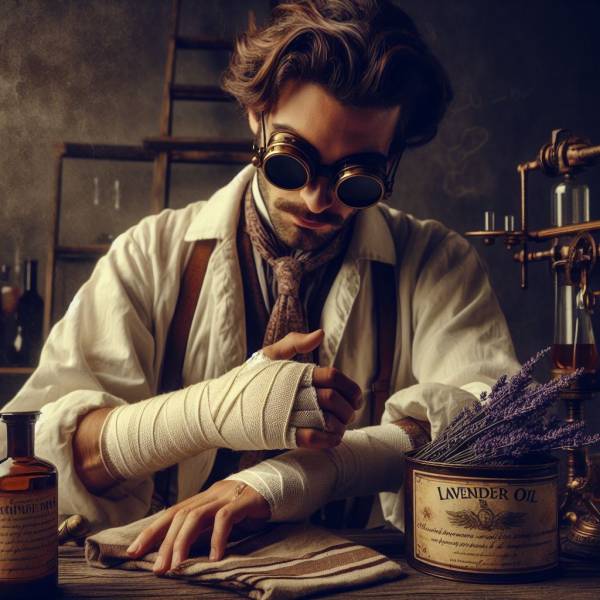This time when fine lavender help Mr. Gattefossé launch modern aromatherapy
This is primarily the story of the explosion experienced by René-Maurice Gattefossé and the fine lavender, one of the most famous in aromatherapy:
René-Maurice Gattefossé was a chemical engineer specializing in the production of floral extracts for perfumes.
The year is 1910. On the day of the birth of his son Henri-Marcel, René Gattefossé suffers an explosion in his company's laboratory.
Severely burned on his hands and with nothing else to relieve the pain, he plunges them into a vat filled with essential lavender oil. To his great surprise, he experiences immediate relief.
Against all expectations, his wounds heal within a few days, leaving no trace.
Amazed by these results, he decides to dedicate himself to researching the therapeutic (healing) properties of essential oils. He is the one who coined the term “aromatherapy,” opening a new field in medicine that would be developed by other great names like Dr. Jean Valnet, Dr. Jos Jullien, and Maurice Mességué.
This story, of course, has a few variations…
Mr. Gattefossé, a researcher fascinated by plants, their chemistry, and their healing potential.
The story of René-Maurice Gattefossé begins in 1881 in Lyon, France. The third of five siblings, he grew up in the world of perfumes, his father Louis being the founder of Établissements Gattefossé in 1880, and a representative in essential oils and raw materials for perfumery. René-Maurice studied chemistry in Lyon and quickly joined the family business, dedicating himself to researching essences and perfumes.
In 1906, he published "The Practical Guide and Formulary for the Modern Perfumer."
René-Maurice Gattefossé and Fine Lavender
In 1907, he met lavender producers from Haute-Provence, discovering their precarious living conditions. He committed himself to improving the cultivation of French lavender, patenting distillation techniques and creating a producers' syndicate. He transformed the sector, increasing the production and recognition of French lavender essence. It was then that he learned from the farmers about the medicinal properties of lavender.
These farmers primarily used the essence of fine lavender as a disinfectant. They applied it pure on cuts and wounds, and also internally against worms and urinary infections.
Only later would the relaxing and soothing virtues of fine lavender essential oil make it a plant widely used against stress and insomnia.
Still passionate, René-Maurice shared his discoveries by founding "La Parfumerie Moderne," an influential journal, where he wrote about lavender and its therapeutic virtues. The journal is digitized and available on the website of the University of Paris 5.
It is important to note that at that time, only the true fine lavender from the population was cultivated in Provence. No selected variety like maillette or any variety of lavandin were yet created or used.
The quality of the fine lavender studied by Mr. Gattefossé is extraordinary compared to what can currently be found in pharmacies or on the internet.
Only a handful of producers on the Albion plateau and the Alpes-de-Haute-Provence still cultivate fine lavender from unselected population seeds. This represents less than 10 tons of production each year for the entire world, because only the terroir of Haute-Provence allows this variety of lavender to grow, flower, and thrive.
The 1910s, Encountering the Virtues of Fine Lavender
René-Maurice continued to characterize essential oils to improve the quality of their use. On July 25, 1910, an explosion in his laboratory caused him severe burns. The greasy tulle dressings used were not effective. Remembering the virtues of lavender, he coated himself in lavender essence, observing a rapid and scarless healing.
He then embarked on the mission to promote aromatherapy in the medical world, studying other essential oils. His experiments in military and civilian hospitals revealed the antiseptic effectiveness of his products, particularly useful in emergency surgery and against epidemics.
Dr. Forgues, a military surgeon in Lyon, collaborated with him to develop antiseptic formulations based on essential oils, in which fine lavender played a significant role.
In 1915, after the death of his brother Abel, René-Maurice developed SALVOL, an aromatic antiseptic. During the 1918 Spanish flu, he proved its effectiveness against staphylococci.
Many hospitals successfully used SALVOL. René-Maurice, considering SALVOL a public good, shared its formula freely.
After the death of his brother Robert in 1918, René-Maurice reinforced his conviction about the importance of essential oils. He documented the clinical effectiveness of essential oil treatments in several hospitals in Lyon.
In the 1920s-30s, his experiments gained recognition. He published four booklets on the therapeutic applications of lavender, manufactured antiseptic soaps, creams, and widely distributed SALVOL.
In 1937, he synthesized his work in "Aromatherapy," followed by "Essential Antiseptics" in 1938, tracing 30 years of research.
René-Maurice, both director of Établissements Gattefossé and editor-in-chief of La Parfumerie Moderne, widely shared his knowledge. He also developed a range of veterinary products and turned to dermatology, traveling the world for his research.
A man of science and philosophy, he died in 1950 in Morocco. His son Henri-Marcel took over the company, continuing his father's work.
Conclusion
After a first encounter with lavender in his earliest childhood thanks to his family's trade in this precious essence and its fragrance for the perfume industry.
The interest of fine lavender essential oil imposed itself again on him in his life as a researcher, he knew how to use it and make its disinfectant virtues known to the general public.
His life testifies to the richness of plants and what they have to offer us. Their natural phyto-ingredients for healing the body, the scents of their perfumes for transporting their souls.





